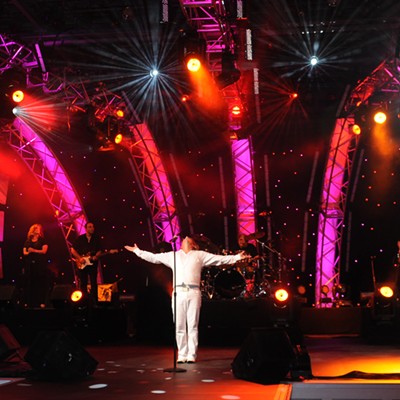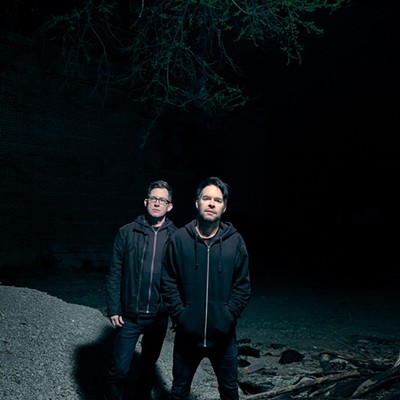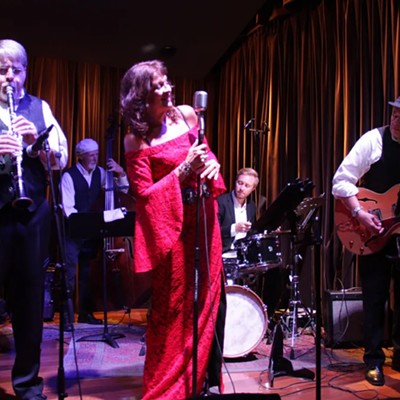Tom Walbank, one of Tucson's most potent and thrilling blues players, first became entranced with the blues when he saw the movie The Blues Brothers, a turn of events that he realizes sounds a little silly.
"In these days of saturated media, when you can get Charley Patton albums at the drop of a hat, it might be comical to younger folks that I came through to the blues from that," Walbank chuckles.
The impressionable 15-year-old was living in his hometown in Devon. As in England. Not the Mississippi Delta, not Memphis, not Chicago.
And although Jake and Elwood Blues played mostly soul music in that film, there was a pivotal performance in it that inspired Walbank to pursue American blues.
"Just before they went into Aretha Franklin's restaurant on Maxwell Street in Chicago, there's a scene with John Lee Hooker, and that's the only blues song in the movie.
"My brother nearly killed me, because I stopped the film and was fast-forwarding through the video to get to the credits and to find out who this guy was. The next day, my brother bought me a John Lee Hooker record, and it was too heavy for me. It was just raw; it was adult shit, and I wasn't ready for it."
But Walbank went out and got a harmonica. "Which was another traumatic experience for me. I wandered into the music store, and I knew nothing about music, and I didn't know whether I should buy the foot-long harmonica or the one with 600 holes."
But a kind salesman suggested the right harp for playing the blues (a Hohner Marine Band, in the key of C), and eventually, his then-girlfriend, who became weary of hearing him play the same riffs over and over, suggested her musician father could share a few tips with Walbank. "She said, 'You're in the wrong key.' I said, 'What's a key?'"
Obviously, in addition to playing scintillating music, Walbank knows how to tell a great story. Another of his talents is art.
Walbank will celebrate the release of his latest CD, Arizona Burning, with a performance Saturday night, April 23, at the M.A.S.T. gallery. The event also is an art opening, presenting Walbank's new show, Centerville, which features his painted interpretations of stills from the 1969 Les Blank film The Blues Accordin' to Lightnin' Hopkins.
Released on his own 009 label, the new CD features re-recorded tracks from throughout his career, as well as four instrumental tracks he recorded for the score of the 2009 independent film Good Boy, directed by Tucsonan Patrick Roddy. The album also includes hints on several tunes of a new direction—mixing blues with Jamaican music such as rock steady and dub. Most notable is "Death Letter Dub," an interpretation of Son House's "Death Letter Blues."
He's also recorded a "sister album" to Arizona Burning, the songs of which are not yet mastered. But he has the material and artwork all collected.
Walbank's been a visual artist longer than he's been a musician.
"As soon as I could pick up a pen, I think, I started drawing." I wanted to be a cartoonist, and specifically to work for a comic book in England called 2000 A.D. It was very kind of subversive and punk-rock when punk rock was coming out."
He went to art college for a while. "And they made it very clear that they didn't think comic art was an art, so I dropped out. This is very different from how it is now; there are graduate courses in comic art now."
There's still a rebellious comic-art swagger in Walbank's paintings, especially his portraiture, although he works in many styles.
"In about 1990, when I could see my focus was going a little bit more on music, I started illustrating blues players, doing portraits, and I've got, like, 600 now."
Born 41 years ago in Somerset, Walbank grew up in a village nearby. He moved to Edinburgh, Scotland, when he was in his early 20s. "To do anything, I knew I had to move out of my town, and I had to move to a city, and I didn't want to move to London, because I knew I would just be swallowed up."
In the early 1990s in Edinburgh, he started playing harmonica with a couple of pals, under the influence of electric blues from Chicago. After that group broke up, he began singing with a guitarist named Steve O'Connor; they called themselves Hot Tamales. "We tossed a coin, and I was the one who ended up singing. That was probably the most terrifying thing I've ever done."
When he first came to the United States, he lived for a while in the San Francisco Bay area with his wife, Leia Maahs, to whom he has been married for 15 years. They moved to Tucson in 2000, and now their family includes a 5-month-old daughter.
He didn't really pick up a guitar until he came to the United States, Walbank says. "Tucson is pretty much where I got my act together, playing harp in a rack, guitar and singing. I started going to the 7 Black Cats, because there was an open-mic night back then, and eventually started meeting people and getting gigs."
He's got some deep-seated values about music. Most important is the song, and next is the rhythm. "I play guitar like a drum. I play harmonica like a drum as well, very rhythmically. If I get too far from the rhythm, I know I am doing something wrong."
He says one of the most exciting things about playing the blues—and music in general—is that every second represents a Zen-like choice.
"The fast songs are just to get people dancing. The hardest thing in blues is to play slow blues and to get that right. You know when the beats are going to drop; you know it's 12 bars, but you've got all that time to make the choice: Where exactly are you gonna put that note? How much stress are you gonna put on that note? If you don't make the right choice, it all falls apart."







